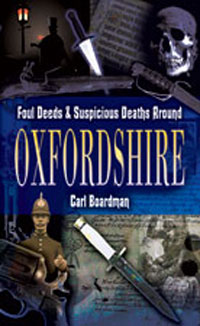Oxfordshire Crime Books Feature |
||
|
|
Foul
Deeds and Suspicious Deaths Around Oxfordshire, |
 |
|
These are curious publications, appealing to various aspects of the potential reader. It is always interesting to see how life was different in previous times, and with a city like Oxford, which has a somewhat posh and virtuous vibe, there is also a certain satisfaction in being reminded that it has the same seedy underbelly as everywhere else. And yet sometimes it doesn’t take long, when immersed in a catalogue of the worst of human nature, to start to feel slightly soiled and want to go and listen to the Beatles for half an hour or so. Much depends, then, in such volumes as these, on how the facts are presented. Foul Deeds and Suspicious Deaths is one of a series of books with the same title applied to different locations. It has twenty-seven chapters, each devoting about five pages to one incident. The style is chatty, full of editorial asides, and sometimes refers to the changes in the law that prompted, or followed from, various events. This last is its main strength: when a murder, robbery or dispute is tied in to the history of the land as a whole the reader gets a sense of significance wholly lacking when it’s just a matter of some ne’er-do-well getting his or her comeuppance after a couple of twists. Crime Death & Debauchery is the more attractive book in terms of cover and layout, and benefits from many splendid illustrations of historical Oxford from the Oxfordshire County Council Photographic Archive. The writing is dryer and more in the style of a court reporter, but the organisation is less formal. Chapters are structured by theme, and may contain one longish feature, or several brief paragraphs, or both. The smaller snippets make up the majority of the work, making it perhaps more something to be dipped into than read through. The piecemeal approach also allows the inclusion of many items which are simply peculiar rather than just criminal. For example: a man fined for throwing snowballs in 1836, the 1723 smoking contest, or the mention of undergraduates Smith and Cromby, who would often “go to chapel drunk and vomit into their hats.” Both books can be recommended, although neither is nearly gripping enough to be read at a sitting. Crime Death & Debauchery is much the classier production and might be considered as a gift, whereas Foul Deeds & Suspicious Deaths, with all the knives and skulls on the cover, has a rather more sensationalist look. Ian Threadgill 12/06/2006 |
||